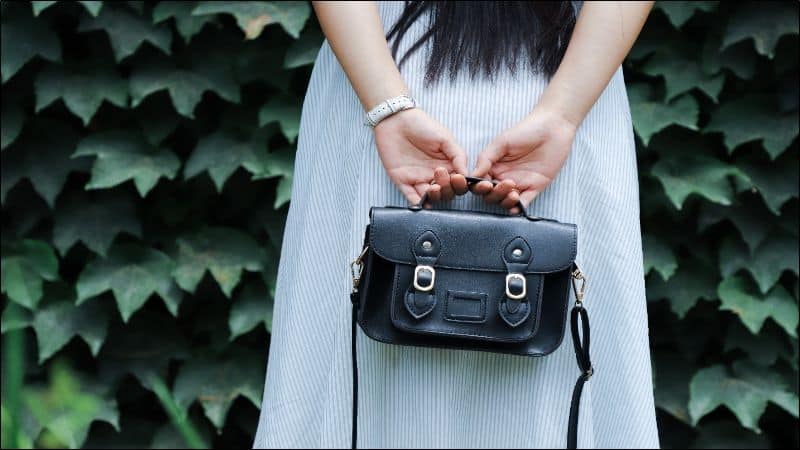Ever found yourself wincing as you swing your favorite handbag over your shoulder? That stylish accessory might be the culprit behind your nagging shoulder pain. It’s not just you; those heavy loads we lug around all day can take a toll on our bodies.

You might think a hefty handbag is just a necessary evil for carrying your essentials, but the truth is, it can lead to more than just a little discomfort. Let’s dive into how that extra weight affects your shoulder and what you can do to ease the strain.
How Does a Heavy Handbag Cause Shoulder Pain?
When you sling a heavy handbag over your shoulder, uneven weight distribution forces your muscles to compensate. Your shoulder muscles work overtime to stabilize the bag’s weight. This overexertion can lead to:
- Muscle fatigue
- Strained tendons
- Nerve compression
Consider the anatomy of your shoulder. It’s a complex network of bones, muscles, and tendons. A heavy load persistently carried on one side causes the shoulder to droop, disrupting this network. Over time, chronic shoulder pain develops.
The type of handbag you carry matters. Structured bags with narrow straps focus the pressure on a small part of the shoulder. Wider straps help distribute the load but they’re not a panacea if the bag’s too heavy.
Let’s talk about posture. Lugging a weighty handbag often leads to poor posture. Your body leans to one side to offset the weight, which can cause spinal misalignment. The result? Pain that can extend from your shoulder down to your lower back.
Here’s a quick glance at the repercussions of a heavy handbag on your shoulder:
| Consequence | Reason |
|---|---|
| Muscle Imbalance | Overworking one side of the body |
| Tendinitis | Chronic overuse of tendons |
| Nerve Impingement | Pressure on shoulder nerves |
| Poor Circulation | Restricted blood flow due to pressure |
| Permanent Postural Shifts | Long-term adaptation to imbalance |
To mitigate these effects, opt for bags with ergonomic features. Look for padded, wide straps or designs that allow for even weight distribution across your body. Remember, the key to a pain-free shoulder might just be a well-chosen handbag.
Understanding the Shoulder’s Anatomy
Your shoulder is a complex structure made up of bones, muscles, and tendons that give you a wide range of motion. Think of it as a sophisticated machine; every part has to work perfectly for it to move smoothly. At its core, your shoulder comprises three main bones: the clavicle (collarbone), the scapula (shoulder blade), and the humerus (upper arm bone).
These bones are connected by muscles and tendons forming the rotator cuff, which envelops the shoulder joint. This cuff has a crucial role in lifting and rotating your arm. Ligaments also play a pivotal part by holding the shoulder bones together while allowing the mobility you often take for granted.
Imagine your tendons and muscles like elastic bands. They’re strong but can be stretched and damaged if you’re not careful. That’s why the weight of a heavy handbag can be a big deal. It pulls continuously on one side, forcing the muscles and tendons to work overtime. This stress might not seem like much, but over time, it can wreak havoc.
To maintain balance, your body automatically adjusts to the extra weight. Your muscles react, too, often leading to an overcompensation that results in strain and discomfort. So when you’re reaching for that stylish tote, remember your shoulder’s anatomy and consider giving it a break now and then—after all, you need it in top form to carry off your look with ease.
Common Symptoms of Shoulder Pain
When your shoulder starts to complain, you’ll notice a few red flags. The symptoms can range from mild to severe, and recognizing them early can save you a lot of trouble.
- Persistent aching after carrying your handbag is a telltale sign. It’s not the normal tiredness from a long day; it’s an ache that doesn’t quit.
- Stiffness in your shoulder can creep up on you. This can make simple movements like reaching for your coffee feel like a Herculean task.
- Decreased range of motion is another symptom to watch for. If swinging your handbag over your shoulder suddenly feels like a stretch, that’s a signal something’s off.
- Swelling or tenderness around the shoulder might appear, especially where the strap rests.
- Sharp pains when lifting objects or during specific movements could indicate that the heavy handbag has caused more than just temporary strain.
If you’re experiencing any of these symptoms, it’s likely due to the constant load you’ve been lugging around. Remember, a heavy handbag can tax your shoulder in ways you might not notice until the pain sets in. It’s not just about discomfort; it’s about maintaining the health and function of your shoulder. Keep an eye on your symptoms and consider lightening your load before your shoulder bears the brunt of a fashion statement.
The Impact of Heavy Handbags on Shoulder Health
You’ve likely felt the burden of a heavy handbag on your shoulder. It’s not just a discomfort; it’s a health concern. Prolonged carrying of heavy handbags can lead to significant shoulder issues, including muscle strain, tendonitis, and nerve damage.
Muscle Strain – Your shoulder muscles bear the brunt of the bag’s weight. Over time, this results in muscle fatigue and strain. Symptoms might not appear immediately, but you’ll feel them increasingly as the strain becomes chronic.
- Tender muscles
- Muscle spasms
- Loss of strength
Tendonitis – The weight of a stuffed handbag can overstress the shoulder tendons, leading to inflammation known as tendonitis. You shouldn’t ignore this; repeated stress without proper rest can cause lasting damage.
- Swelling
- Heat sensation
- A clicking noise during movement
Nerve Damage – A heavy handbag presses against your shoulder, potentially compressing the nerves. This condition, often reversible, could result in various nerve-related symptoms if left unchecked.
- Numbness
- Tingling sensations
- Shooting pain down your arm
Beyond these ailments, heavy handbag use can also cause postural problems. The weight imbalance leads to an uneven posture, which, over time, can alter the spine alignment and lead to back pain.
- Uneven shoulders
- Forward head posture
- Increased spinal curvature
« Can You Take a Handbag on Jet2? Unpacking the Must-Know Tips
How Should You Store Handbags? Protect Your Investment with These Pro Tips »
Adopting a proactive approach is vital. Alternate shoulders regularly. Opt for wider straps. Lighten the load whenever possible. Finding the right balance between fashion and health might require a little effort, but your shoulders will thank you for it. Consider the materials and design of your handbag. A functional, fashionable, and shoulder-friendly handbag is within reach — you don’t have to sacrifice style for comfort.
Tips for Reducing Shoulder Pain from Heavy Handbags
Alleviating shoulder pain caused by heavy handbags is simpler than you might think. Start by purging unnecessary items from your bag; it’s easy to accumulate things you don’t need. Aim to carry only the essentials and consider downsizing to a smaller bag to avoid the temptation of overloading.
Opt for bags with wide, padded straps as they distribute weight more evenly across your shoulder. Narrow straps can dig into your skin and increase pressure on your shoulder, exacerbating pain. If you can’t part with your current handbag, look for a strap cushion that can be added for extra comfort.
Rotate the shoulder on which you carry your bag regularly. By switching sides, you’ll prevent overworking one side of your body, helping to maintain balance in muscle use and posture.
When packing your bag, organize contents strategically. Place heavier items at the bottom and closer to your body. This helps in keeping the weight centralized and maintains your balance.
Engage in exercises designed to strengthen the shoulder muscles. Stronger muscles can handle the stress of carrying a handbag better and are less prone to injury. You don’t need a gym membership for this – even simple at-home exercises can make a difference.
Consider alternative bag styles. Crossbody bags can be a better option as they allow the body to carry weight more evenly. Backpack-style bags, including chic, fashionable options, are also a great choice for better weight distribution.
Lastly, if you often find yourself requiring numerous items throughout the day, plan ahead. Leave extra items in your car or office, or stow them in a separate bag that you don’t need to carry with you at all times. This way, your shoulder carries less and you still have everything you need within reach when necessary.
Staying mindful about how you use and choose your handbags can lead to a significant reduction in shoulder pain. Simple adjustments go a long way in ensuring both your comfort and your style remain intact.
Conclusion
So there you have it—you don’t have to sacrifice style for comfort. By making a few mindful changes to how you pack and carry your handbag, you can say goodbye to that nagging shoulder pain. Remember to keep it light, switch it up, and choose wisely when it comes to straps and bag styles. Your shoulders will thank you for it. Now go ahead, give your bag a makeover and strut your stuff with confidence and ease!
Frequently Asked Questions
How can I reduce shoulder pain caused by heavy handbags?
To reduce shoulder pain, carry only the essentials, use bags with wide, padded straps, alternate shoulders, organize items strategically, strengthen your shoulders with exercises, and consider other bag styles like crossbody or backpacks.
What type of strap is best for preventing shoulder pain from handbags?
Bags with wide, padded straps are best as they distribute the weight more evenly. Adding a strap cushion can also increase comfort.
Is it important to switch the shoulder I carry my bag on?
Yes, it is important to alternate the shoulder on which you carry your bag to avoid overworking one side of your body and to prevent muscle imbalances.
How should I organize the contents of my handbag to reduce shoulder pain?
Place heavier items at the bottom of your bag to maintain balance and prevent the bag from pulling on one side, which can lead to shoulder pain.
Can shoulder-strengthening exercises help with handbag-induced shoulder pain?
Yes, shoulder-strengthening exercises can help alleviate shoulder pain by building muscle and improving posture.
Are alternatives to traditional handbags better for shoulder pain?
Alternative bag styles, such as crossbody or backpack-style bags, can help alleviate shoulder pain as they distribute weight more evenly across the body.
What is a quick tip for instantly reducing the load on my shoulder from a heavy handbag?
A quick tip for instantly reducing the load is to purge unnecessary items and plan ahead by leaving extra items in your car or office instead of carrying them on your shoulder.










